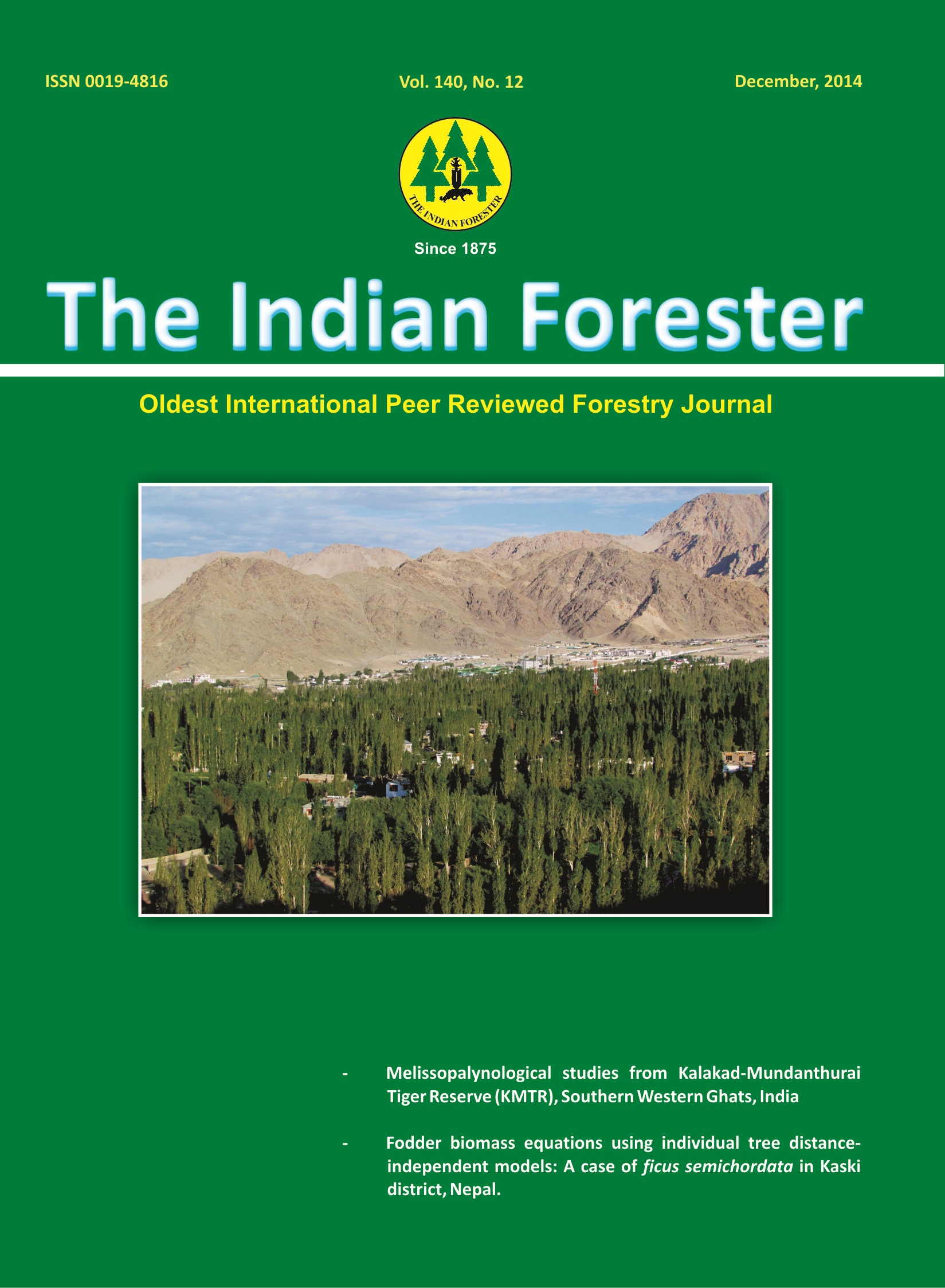Foraging Behaviour of Odontotermes wallonensis Wasmann
DOI:
https://doi.org/10.36808/if/2014/v140i12/55293Keywords:
Disturbance, Foraging Preference, Odontotermes wallonensis, TermiteAbstract
Contrary to the common perception that termites are indiscriminate eaters, termites choose their food carefully; however, the methods by which they choose food are not well understood. The movement of foragers of Odontotermes wallonensis, subterranean, mound building termite was investigated in their natural habitat using artificial feeding sites. Wooden blocks of different sizes were used to record foraging of termites and results revealed that for termites "size matters". Bigger the food source higher the preference. Termites selected larger sized baits over smaller one and also disturbance on the baits seems to have influence on the selection of food.References
Araujo A.P.A., Araujo F.S.D. and Desouza O. (2011). Resource Suitability Affecting Foraging Area Extension in Termites (Inecta, Isoptera) Sociobiology, 57(2):1-13
Badawi A., Faragalla A. and Dabbour A. (1984). Population studies of some species of termites in Al-Kharj, Oasis, Central Region of Saudi Arabia. Z. Ang. Ent., 97:253-261
Cornell H. and Lawton J. (1992). Species interactions, local and regional processes, and limits to the richness of ecological communities: a theoretical perspective. Journal of Animal Ecology, 61:1-12
De Souza O., Araujo A.P.A. and Reis-Jr R. (2009). Trophic controls delaying foraging by termites: reasons for the ground being brown?. Bulletin of Entomological Research, 99:603-609
Eisner T., Kriston I. and Aneshansley D.J. (1976). Defensive behavior of a termite (Nasutitermes exitiosus). Behavioural Ecology and Sociobiology, 1: 83–125.
Evans T.A., Lai J.C.S., Toledano E., McDowall L., Rakotonarivo S. and Lenz M. (2005). Termites assess wood size by using vibration signals. P Natl Acad Sci-Biol., 102: 3732-3737
Forschler B.T and Townsend M.L. (1996). Mark –release-recapture estimates of Reticulitermes spp (Isoptera: Rhinotermitidae) colony foraging populations from Georgia, USA. Environmental Entomology, 25:952-962
French, J.R.J., Ahmed B. and Ewart D. (1995). Bait box technique for remedial subterranean termite control The International Research Group on Wood Preservation, Document No IRG/WP/95-10115
Grace J.K and Campora C.E. (2005). Food location and discrimination by subterranean termites (Isoptera: Rhinotermitidae) Proceedings of the Fifth International Conference on Urban Pests (Eds) Chow-Yang Lee and William H Robinson
Haverty M.I., Nutting W.L. and La Fage J.P. (1975). Density of colonies and spatial distribution of foraging territories of the desert subterranean termite, Heterotermes aureus (Snyder) Environmental Entomology, 4:105-109
Hedlund J.C and Henderson G. (1999). Effect of available food size on search tunnel formation by the Formosan subterranean termite (Isoptera: Rhinotermitidae) Journal of Ecological Entomology, 92 (3):610-616
Howard R.W. and Haverty M.I. (1979). Comparison of feeding substrates for evaluating effects of insect growth regulators on subterranean termites. Journal of the Georgia Entomological Society, 14: 3–7.
Jones S.C. (1990). Colony size of the desert subterranean termite Heterotermes aureus (Isoptera: Rhinotermitidae). South-western Naturalist, 35:285–291
Kakkar R. and Nagaraja R. (2011). Studies on carbon sequestration in forest research plantations of Bangalore research circle, My Forest, 47(1):5-10
LaFage J.P., Nutting W.L. and Haverty M. (1973). Desert subterranean termites: a method for studying foraging behaviour. Environmental Entomology, 2:954-956
Lee S.H., Su N.Y. and Bardunias P. (2007). Optimal length distribution of termite tunnel branches for efficient food search and resource transportation. Biosystems, 90:802–807
Lenz M. (1994). Food resources, colony growth and caste development in wood-feeding termites. pp. 159–209 In: Nourishment and evolution in insect societies. (Hunt, J.H. & Nalepa, C.A. (Eds) Boulder, Colorado, Westview Press.
Lindstrom M. and Norin T. (1990). Chirality of the monoterpene alarm pheromones of termites. Naturwissenschaften, 77: 134–135.
Mugerwa S., Nyangito M., Mpairwe D.and Nderitu J. (2011). Effect of biotic and abiotic factors on composition and foraging intensity of subterranean termites. African journal of Environment Science & Technology, 5(8):579-588
Ra Inta Joseph, Lai C.S., Fu E.W. and Evans T.A. (2007). Termites live in a material world: exploration of their ability to differentiate between food sources. J. R. Soc. Interface, 4:735–744
Rust M.K., Haagsma K. and Nyugen J. (1996). Enhancing foraging of western subterranean termites (Isoptera: Rhinotermitidae) in arid environments. Sociobiology, 28: 275–286.
Sobotnık J., Hanus R .and Roisin Y. (2008) Agonistic behavior of the termite Prorhinotermes canalifrons (Isoptera: Rhinotermitidae). Journal of Insect Behaviour, 21: 521–534.
Suoja S.B., Lewis V.R. and Wood D.L. (1999). Comparisons of single and group bioassays on attraction and arrestment of Reticulitermes sp. (Isoptera: Rhinotermitidae) to selected cellulosic materials. Sociobiology, 33: 125–135.
Traniello J.F.A and Leuthold R.H. (2000). Behavior and ecology of foraging in termites In Termites: Evolution, Sociality, Symbioses, Ecology. (eds Abe, T, Bignell, D E and Higashi, M), Kluwer, Dordrecht, pp 141–168
Ulyshen M. and Shelton T. (2012). Evidence of cue synergism in termite corpse response behavior. Naturwissenschaften, 99: 89–93.
Werner E.E.A., and Mittelbach G.G. (1981). Optimal foraging: field tests of diet choice and habitat switching. American Zoology, 21:813-829
Wood T.G., Johnson R.A. and Ohiagu C.E. (1977). Population of termites (Isopteran) in natural and agricultural ecosystems in Sou thern Guinea Savanna near Mokwa, Nigeria Geo-Eco-Trop, 1:139-148
Zimmer-Faust R.K. (1987). Crustacean chemical perception: Towards a theory on optimal chemoreception. The Biological Bulletin, 172:10-29
Downloads
Downloads
Published
How to Cite
Issue
Section
License
Unless otherwise stated, copyright or similar rights in all materials presented on the site, including graphical images, are owned by Indian Forester.





